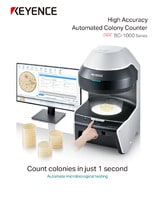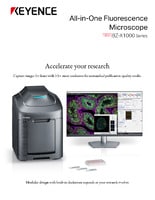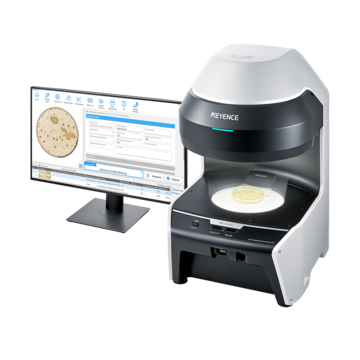FAQs for Automated Colony Counters
Automated colony counters are still relatively new so KEYENCE experts put together this FAQ page to help you learn more about this technology! This advanced technology streamlines the process of counting microbial colonies to provide accurate, efficient, and traceable results with minimal effort. Whether you are in a research laboratory, quality department, or educational institution, automated colony counters are designed to meet your needs and streamline inspection processes.
On this page, you will find answers to frequently asked questions about automated colony counters from the general operation, capabilities, specifications, and applications. This page will also include information on KEYENCE's BC-1000 Series Automated Colony Counter!
If you can't find the answer you're looking for on this page or want more information on the BC-1000 Series, please reach out to KEYENCE via the web chat, lifescience@keyence.com, or call in and ask to speak with our support team.
Frequently Asked Questions and Answers
What Types of Sample Mediums Can Be Used?
It will depend on the automated colony counter but they typically can work with petri dishes, 3M™ Petrifilm™ plates, CompactDry™ plates, media pads, well plates, and more!
The BC-1000 Series Automated Colony Counter is extremely flexible and can work with all of the forementioned sample mediums (petri dishes, 3M™ Petrifilm™ plates, CompactDry™ plates, media pads, well plates, etc).
What Types of Bacteria Can Be Tested and Counted?
Typically, automated colony counters can work with almost any type of bacteria such as E. coli, salmonella, legionella, coliform, and more!
The BC-1000 Series Automated Colony Counter is capable of working all types of bacteria but we suggest setting up a demo with your local specialist to run sample testing to prove it! Contact KEYENCE via the web chat, lifescience@keyence.com, or call to speak with a specialist.
How Long Does It Take to Count a Sample?
This will depend on the automated colony counter, but it will be 10x faster than manual colony counting.
With the BC-1000 Series, it only takes 1 second to count a sample!
How Many Colonies Can Be Counted on a Single Sample?
This will depend on the automated colony counter.
The BC-1000 Series can count more than 100,000 colonies as long as they are in the system's field of view! Even though it's probably unnecessary for most microbiological testing needs, the BC-1000 Series has counted samples with thousands of colonies without issue.
What Types of Reports Can Be Output?
Not all automated colony counters are capable of automatically generating a report.
The BC-1000 Series can output two main types of reports: a count report and a zone of inhibition report. Both of these reports can use a default report format or you can customize your own.
Is The BC-1000 Series Calibrated?
Not all automated colony counters are calibrated but the BC-1000 Series comes calibrated! However, while calibration itself is possible, automated colony counters may not be sufficient as a measuring instrument as accuracy is not guaranteed. KEYENCE also offers an optional calibration plate/reference scale that can be purchased so that users can calibrate the system at their facilities.
Will The BC-1000 Series Integrate with My LIMS?
Yes, KEYENCE's BC-1000 Series can integrate with your LIMS. This system can export the following types of files: .csv, excel, .jpg, and .tif which can be imported into most LIMS software.
Is The BC-1000 Series Compliant with Any Industry Standards?
Absolutely, the BC-1000 Series is compliant with many industry standards which includes 21 CFR Part 11.
What is The Smallest Colony The BC-1000 Series Can Count?
The BC-1000 Series can count colonies as small as 50 µm, making this system a better option for detecting colonies. Due to this capability, the system makes it possible to count small colonies with a shorter incubation time.
What Information Does The BC-1000 Series Provide?
Unlike manual colony counting methods, the BC-1000 Series will provide users with a lot more information than just a colony count but also the size and distribution data, along with an image of the sample.
Is Counting Possible with Containers Other Than Petri Dishes?
KEYENCE’s BC-1000 Series Automated Colony Counter can be used with sheet culture media and well plates, in addition to Petri dishes. The system offers holders for each type of container.
Do Results Comply with FDA 21 CFR Part 11 Requirements?
The BC-1000 Series includes various features such as user management and audit trails that allow for compliance with 21 CFR Part 11.
Compliance with counting methods of various other standards—including FDA BAM, AOAC 977.27, GB 4789.2, GB 7918.2, ISO 7218, ISO 4833.2, and ISO 15189—is also possible.
What Is Data Integrity (DI)?
Data integrity (DI) refers to data that is complete, consistent, and accurate. In other words, data integrity refers to the reliability of the data.
This is a basic requirement of Good Manufacturing Practices (GMP; Pharmaceutical Manufacturing Control & Quality Control Standards), a pharmaceutical industry concept that manufacturers are required to comply with.
Data integrity is a requirement for all types of recording media, and appropriate measures must be taken regardless of the recording method (paper, digital, etc.).




